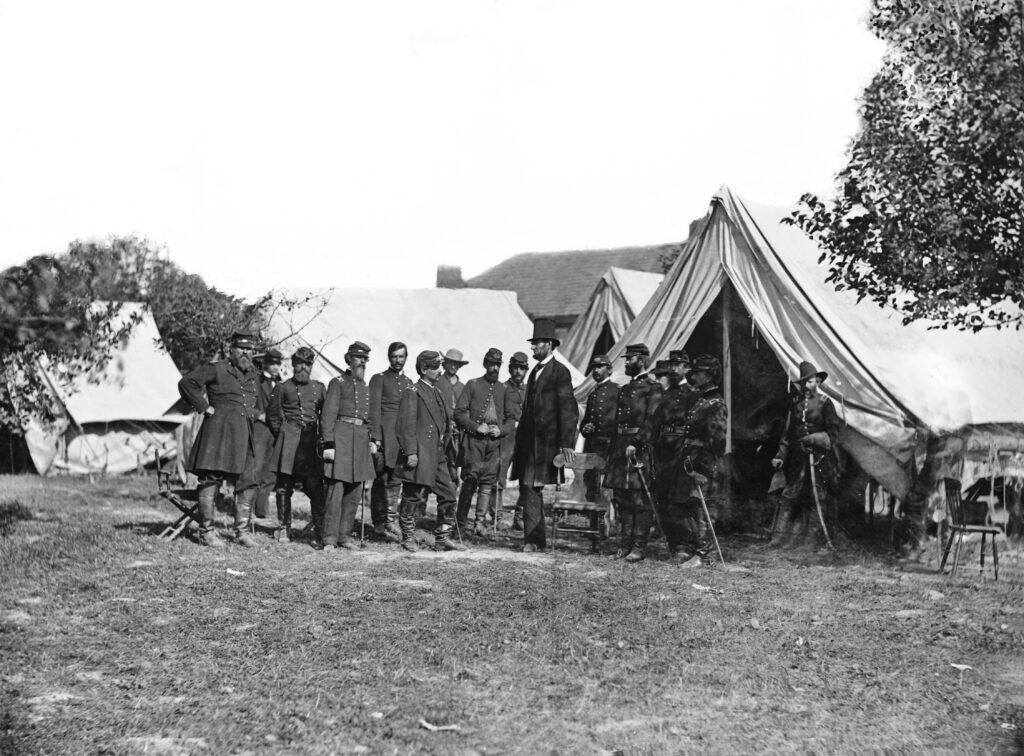The American Civil War was a pivotal moment in American history, with the conflict between the Union and the Confederacy resulting in the loss of hundreds of thousands of lives.
One of the war’s most significant battles was the Battle of Antietam, fought on September 17, 1862, in Maryland. It began at dawn when Union troops led by General George McClellan attacked a Confederate force led by General Robert E. Lee in Maryland.
The battle lasted until sunset and left more than 23,000 men dead or injured — more American casualties than any other day in history. It was a critical moment in the Civil War and left a lasting legacy. Today, we look at the story of this fierce battle.
And while you’re here, if you’re a Civil War enthusiast looking to expand your knowledge of the conflict, please consider joining one of our Virginia Civil War Tours. If you want a personalized tour experience, select our Custom Civil War Battlefields of Virginia Tour option.

(Lincoln meeting his generals after the Battle of Antietam)
Background to the Battle of Antietam
To understand the significance of the Battle of Antietam, it’s important to have a brief history of the Civil War leading up to it.
The war had been raging for over a year, with the Confederacy enjoying several key victories that had boosted their morale and threatened the Union’s momentum. Confederate General Robert E. Lee, in particular, had scored several key successes and had recently invaded Maryland, hoping to gain support from local citizens in the border state.
The Union forces, led by General George B. McClellan, were tasked with stopping Lee’s invasion and preserving the Union’s hold on Maryland. Antietam Creek, near the town of Sharpsburg, was a critical strategic point, as it represented the Confederate army’s northernmost advance and the last major obstacle to their potential victory.
The stakes were high for both sides, as the battle’s outcome could have significant implications for the rest of the war. For the Confederacy, a victory could potentially lead to foreign recognition and support, while a Union victory could shift the tide of the war in their favor. As a result, the Battle of Antietam was a critical turning point in the war, with the nation’s fate hanging in the balance.
Overview of the Battle of Antietam
The Battle of Antietam began on September 17, 1862, with Union forces under General McClellan facing off against Confederate forces under General Lee. The initial engagements were fierce, with both sides taking heavy losses in the opening hours of the battle. The Union forces managed to push the Confederates back, but the fighting continued throughout the day, with both sides trading blows and trying to gain the upper hand.
The battle was divided into three phases: the morning phase, the midday phase, and the afternoon phase. During the morning phase, Union forces pushed back Confederate troops and gained some ground. However, the Union’s momentum was slowed during the midday phase, with Confederate troops holding their ground and launching several counterattacks. In the afternoon phase, the Union forces launched a final assault, leading to a brutal struggle that resulted in heavy losses on both sides.
The Battle of Antietam saw several notable commanders and soldiers on both sides. For the Union, General McClellan led the charge with other notable commanders, including General Ambrose Burnside and General Joseph Hooker. General Lee was the central figure on the Confederate side, with other notable commanders, such as General Stonewall Jackson and General James Longstreet.
The battle also saw the involvement of soldiers such as Union Corporal Barton W. Mitchell, who found a copy of Lee’s battle plans and helped turn the tide of the battle.

(Damage to the Lutheran Church at Sharpsburg shows the ferocity of the shelling during the Battle of Antietam)
Casualties and Aftermath at Antietam
The Battle of Antietam was a brutal affair, with both sides suffering heavy casualties. The battle resulted in nearly 23,000 casualties, with around 4,000 killed and over 18,000 wounded. The staggering loss of life made the Battle of Antietam the bloodiest day in American history.
The impact of the battle was significant, with the Union managing to repel the Confederate advance and preserve their hold on Maryland. While the victory was not a decisive one, it gave the Union a much-needed boost and set the stage for further victories down the road.
Additionally, the battle led to President Abraham Lincoln issuing the Emancipation Proclamation, which declared that all slaves in Confederate territory were to be freed, further shaping the course of the war and the country’s history.
The aftermath of the battle saw the Confederate army retreating into Virginia and the Union army remaining in control of the battlefield. The strategic implications of the battle were significant, with the Union gaining ground and momentum and the Confederacy suffering a major setback.
The Battle of Antietam proved to be a pivotal moment in the Civil War, shaping the course of the conflict and the country’s history for years to come.

(Confederate and Union soldiers lie dead before Dunker Church)
Antietam’s Legacy and Commemoration
The Battle of Antietam has been remembered and commemorated in various ways. In the years following the battle, several monuments and memorials were erected to honor the soldiers who fought and died on both sides. The Antietam National Battlefield was established in 1890 to preserve the site and provide a place for visitors to learn about the battle and its significance.
Today, the Antietam National Battlefield is a popular destination for history enthusiasts, with several key monuments and memorials. These include the Maryland Monument, which honors the soldiers from the state who fought in the battle, and the Dunker Church (pictured above), which served as a makeshift hospital during the conflict. The battlefield also hosts several events yearly, including reenactments and educational programs.
The importance of remembering and studying the Civil War and its impact on American history cannot be overstated. The war played a pivotal role in shaping the country’s history and identity and continues to influence our society and culture today. And with Antietam ranking among the most crucial battles of the war, its importance cannot be in doubt.
Visiting the Battlefield Today
The Battle of Antietam was a defining moment in American history, with significant strategic and political implications for the Union and Confederate forces. The battle resulted in a staggering loss of life and was a turning point in the Civil War.
Today, the battlefield serves as a place of remembrance, reflection, and a testament to the sacrifices made by the soldiers who fought and died on that fateful day. Antietam is beautifully preserved thanks to its rather remote location and battlefield preservation efforts over the years.
We encourage readers to visit the Antietam National Battlefield and learn more about this pivotal moment in American history. By studying and reflecting on past events, we can gain a deeper appreciation for the sacrifices made by those who fought in the Civil War and better understand the impact of this conflict on the nation’s history and identity.
In Virginia, you will find the battlefields that gave Lee and Jackson great success and encouraged Lee to invade the North for the first time, leading to the battle of Antietam. These battles include the Seven Days’ Battles and Cedar Mountain. Follow the armies after the battle to Fredericksburg, Virginia, where another bloody day in American history occurred.
If you are traveling in Virginia and would like to explore the state’s battlefields with expert guides, please consider joining us for a Civil War Driving Tour of Virginia’s Battlefields.
If you have any questions, please get in touch.
Continue reading about the history of the US Civil War by reading Was the American Civil War Avoidable?.


